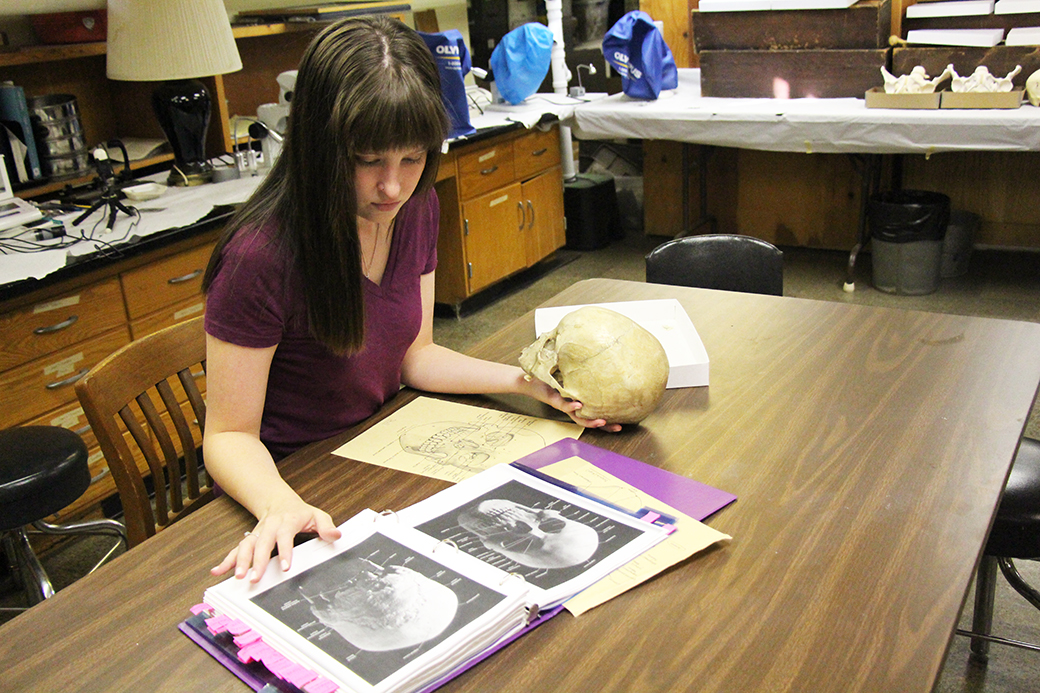
Archaeology lab allows students to gain hands-on experience
Down in the basement of East Hall, undergraduate students are examining human remains, extinct animals and seed collections in an archaeology lab.
The lab is made up of three separate facilities: a historical archaeology space, an area for fine-tuned microscopes, and osteology and seed collections. The department also uses the lab to analyze samples from the field school in Peru they take students to every summer.
“We have a long history of having some very good archaeologists come out of this university,” Matthew Sayre, an anthropology professor said. “Not very many universities have field schools and our program is a very unique.”
Sayre said the lab studies samples from South Dakota along with samples people send in from all over the country.
“We currently have students analyzing plant remains from archaeological sites in Peru and New Mexico,” he said. “The two students working on that are not just looking at what people ate in the past but also how they managed the environment around them.”
The program to Peru has been very popular, Sayre said, who has been a leader of the trip since 2012.
One group of students even created a documentary during their trip, he added.
“It aired on SDPB last month, and we’ll have a screening of it on campus on Nov. 18 at 6:30 in the MUC,” he said. “It’s something we will be able to distribute nationally to show the country what students at USD are doing and to show them the importance of a field school.”
There are other opportunities offered through the lab that are a little closer to home, like research on extinct buffalo and other state collections.
Once students complete entry level classes they can move to more in-depth, specific research, Sayre said.
“Every year we take students to a national conference to report their findings,” he said. “Showing that they have done actual research and presenting that research is really useful.”
Sayre said his most exciting moment as an instructor in the lab was when a student conducted research on the massacre site of Crow Creek in South Dakota – a site where hundreds of people were buried after being killed in battle hundreds of years before Europeans settled in North America.
That student’s research challenged assumptions from previously-done work, Sayre said.
By observing that the bones from the men and women had the same marks, the student was able to prove the women stood and fought alongside the men, and had not run away as previously thought.
“It’s the only time I have been to a national conference and seen a student present a paper and get a standing ovation,” Sayre said.
Silvana Rosenfeld, another anthropology professor, said watching students learn with hands-on activities is her favorite part of the lab.
“We do quizzes every week and there are stations set up in the lab. Looking at (the students) when the bulb lights up and know(ing) they are learning is more rewarding than a lecture-based class,” she said. “Really having a class that is hands on material is very cool”
Criminal justice, archaeology, sustainability and medical students all take classes in the lab, Rosenfeld said.
Senior Brianna Williamson, who’d like a career in forensic anthropology, is one student involved in the program.
“Its just my favorite thing. I kind of got hooked on it when I took Dr. Rosenfeld’s osteology class,” she said. “My favorite thing down here is analyzing all of the bones we have, whether its human or animal remains.”
Williamson said her experience from the lab at USD helped her get an internship at the Siouxland Heritage museums in Sioux Falls.
“That was really fun because we got to get more experience with museum life,” she said. “I was actually able to get some bones that we had in the basement and bring them back here for analysis. That was really cool.”
In addition to being enrolled in two lab classes, Williamson also helps out with other classes in the department.
“It’s going to help me be more experienced for what I want to go into in graduate school,” she said. “This semester I come down here because I am taking a forensic anthropology class and it has helped me because I can come down here and analyze the casts and bones we have. I’m down here about two hours a week just analyzing and it helps in my class a lot. It’s a lot of fun down here.”


